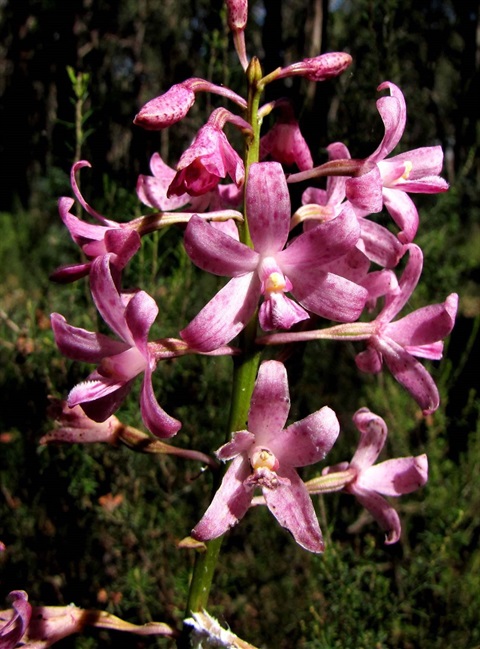
Dipodium roseum
Rosy Hyacinth-orchid
Saprophytic herb (relying on dead or decaying plants for food. Erect, leafless thick green to purplish-red stem with overlapping sheaths at the base.
Additional information
- SynonymSeparated from Dipodium punctatum
- FamilyOrchidaceae
- StoreyLower storey
- Sizestem 0.3-0.9 m high
- Plant groupingOrchids
- LeavesAbsent.
- Flower colourRose pink with small darker pink to red spots
- Flowering timeDecember to April
- FlowersSpike of 15-40 stalked, open flowers. Albino forms rare. Sepals and petals are curved back at the tips. Lip (labellum) has darker pink lines.
- Bird attractingNo
- Butterfly attractingAttracts native bees
- Frog habitatNo
- Growing conditionsWell drained soil, often poor or rocky, in open forests. Often found growing close to the base of eucalypts. Semi shade and dappled shade.
- Garden useNever remove orchids from the bush. Saprophytes do not produce chlorophyll and live off decaying material. Cannot be cultivated.
- Commercially availableNever
- Conservation statusWidespread within the Shire
- Aboriginal Use Food - tuber
- Related speciesThere is a report of Dipodium campanulatum from one site in the Dandenong Ranges. It can be distinguished by the white bell-shaped flowers which are red spotted. The labellum has red-pink blotches rather than stripes. D. punctatum is also recorded within the Shire. The 15-30 flowers are pale to bright pink with heavy darker blotches and open widely. The petals and sepals are not curved back.
Photo Gallery
Photographer/s: 1 David Blair ©; 2, 3 Richard Hartlands ©; 4 Marilyn Bull ©
Plant Communities